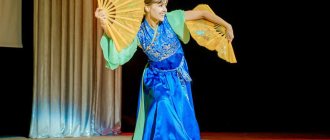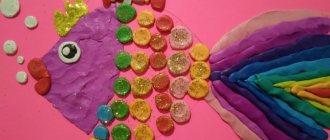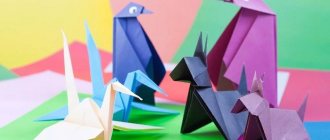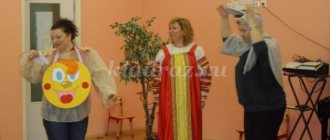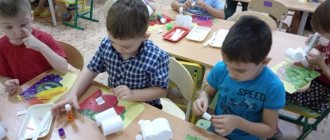Work program of the "Origami" circle for children of senior preschool age
Explanatory note
The creative development of a child is an integral part of the educational process, aimed at developing in preschoolers an interest in professions of various kinds, as well as in the history of folk art, introducing them to folk crafts and instilling respect for physical labor.
To achieve the above goals, the Federal State Standard for Preschool Education was developed (order No. 1155 dated October 17, 2013. The legal and documentary basis for the Program for the spiritual and moral development and education of preschool children is the Law of the Russian Federation “On Education”, the Standard, as well as the Concept of Spiritual -moral development and upbringing of the personality of a Russian citizen.In accordance with the requirements of the Standard, the above documents are a guideline for the formation of all sections of the basic educational program of primary general education.
According to the Federal State Educational Standard for Preschool Education, the most important task of preschool education is the comprehensive personal development of children, based on activities appropriate for preschool age, such as play, visual arts, construction, perception of fairy tales, etc. Also, one of the ways to develop a creative personality, according to the Federal State Educational Standard, is to create various crafts with your own hands - such an activity allows you to acquire skills and abilities for the development of subtle and precise movements, confident control of your body, increasing intelligence and volitional abilities, which is the key to successful development by a preschooler primary education programs in the future.
Classes in the “Modular Origami” circle are work based, first of all, on children’s observation and mastery of the surrounding reality, its personal reflection and the formation of their own attitude towards it, active creative search. Used as a means of additional education, this program will help introduce children to the world of the ancient art of folding paper without scissors and glue, creating real masterpieces with their own hands.
This program is intended for older preschoolers and is aimed at mastering it by children aged 5–7 years, which corresponds to the key needs of this age in the development of creative abilities. During its development, children are expected to develop such skills as:
- development of small muscles of the fingers;
— balanced development of logical and imaginative thinking;
— formation of spatial representations;
— the ability to stage-by-stage plan your activities and bring them to the desired result;
— broadening one’s horizons;
- satisfaction of cognitive interests.
The program is aimed at creating a common culture for children, at their spiritual, moral, social, personal, and intellectual development, at creating the foundations for their independent implementation of creative activities that ensure social success, the development of creative abilities, self-development and self-improvement.
The relevance of the “Modular Origami” circle program is that it will allow you to enrich communication skills and acquire the ability to carry out joint activities in the process of mastering the program. The program promotes the development of personal cognitive processes and the socialization of the child by introducing him to useful creative activities. The proposed system of practical classes will make it possible to form, develop and correct spatial and visual concepts in older preschoolers, as well as help children easily and joyfully be involved in the educational process in the future.
The pedagogical feasibility of the “Modular Origami” club program is due to the importance of creating conditions in a preschool institution for the effective formation in children of spatial concepts, logical thinking, geometric concepts, development of motor skills and the eye.
The program involves working with children in the form of individual lessons, joint work of children with a teacher, as well as their independent creative activity.
This program has the following distinctive features:
— the ability to adjust tasks during the learning process depending on the experience of children and the degree of their assimilation of educational material;
— inclusion in the program not only of teaching modular origami, but also the creation by children of individual and collective plot-thematic compositions using the presented technique;
— use during classes of audio materials with recordings of sounds of living nature and music in order to relieve tension and excessive excitability in children.
The “Modular Origami” circle program is designed for 33 hours (1 year of study in a preparatory group, 1 lesson per week for 1 hour), during which both group lessons and the provision of individual assistance by the teacher to each child are assumed.
The goal of the program is to develop the creative abilities and cognitive sphere of children of senior preschool age by introducing them to the art of modular origami.
To achieve the goal of the program, it is expected to complete the following program objectives during the training process :
— teaching children how to use modular origami techniques;
— assimilation of the initial experience of self-realization;
- development of imagination, artistic taste, sense of beauty;
- fostering hard work and a creative attitude to work;
- formation of ideas about creative ideals.
Work on mastering the program is carried out in stages (over two half-years), so we consider it advisable to highlight educational tasks for each half-year:
Tasks for the first half of the year:
1. Introduction to the art of origami, its history, basic principles.
2. Introduction to basic origami figures.
3. Development of the ability to work with scissors and paper, cultivation of accuracy, perseverance, and patience.
4. Children’s assimilation and memorization of necessary terms and concepts.
5. Learning to create origami, made by repeatedly folding corners.
6. Forming a desire to independently fold figures using the origami technique, practicing already learned techniques.
7. Development of voluntary attention, interest in manual labor, creativity.
8. Demonstration of children’s achievements (creation of an exhibition of products).
Tasks for the second half of the year:
1. Development of the ability to freely operate with the basic terms of origami modeling.
2. Learning to nest side triangles and sides inside.
3. Consolidating the skill of folding with a fold.
4. Creating a conscious interest in origami.
5. Development of self-control and self-esteem.
6. Consolidating the ability to operate with the basic concepts of origami technique.
7. Introduction to modular origami.
8. Creation of products from modules (swan, tulip, pineapple, hare).
9. Development of a sense of beauty, aesthetic interests.
10. Formation of the desire to independently create products using the modular origami technique.
11. Demonstration of children’s achievements (creation of an exhibition of products).
In the course of implementing the program’s objectives, it is expected to use such teaching methods as:
1. Methods based on the way of organizing classes:
- verbal method (oral presentations, conversations, stories);
— practical method (carrying out work according to instructions, maps, diagrams).
2. Methods based on the level of children’s activity:
— explanatory and illustrative methods (children’s perception of ready-made information);
— reproductive methods (reproduction by preschoolers of acquired knowledge and mastered methods of activity);
- partially - search methods (methods that involve a collective search and solution of the problem together with the teacher);
— research methods (consisting of children carrying out independent creative work).
3. Methods based on the form of organizing children’s activities in the classroom:
— frontal methods (simultaneous work of the teacher with all children);
- individual - frontal methods (individual and frontal forms of work alternate);
— group methods (organized work of children in groups);
- individual methods (individual completion of tasks and educational problems by children).
Contents of the program.
Week 1. Theoretical lesson “Introduction to origami” (history of the direction, types).
Week 2. Introduction to the concept of “basic shapes” and their application in origami technique.
Week 3. Practical lesson. Manufacturing of the basic “square” shape and products based on it.
Week 4. Introduction to origami symbols.
Week 5. Terms used in origami. Pocket (wallet).
Week 6. Practical lesson “Stylized flower”. Working with the basic shape "Triangle".
Week 7. Practical lesson “Little Fox and the Dog.” Studying marking by bending. Introduction to the concept of graphic images and their purpose. Planning work based on graphic instruction cards.
Week 8. Practical lesson “Yacht and steamship”. Introducing techniques for reading origami diagrams. Exercises on dividing rectangular and square workpieces in different directions into equal and unequal parts.
Week 9. Practical lesson “Glass”. Making products using the origami technique based on instruction cards (subject and graphic).
Week 10. Practical lesson “Tit and bullfinch”. Creation of the composition “Birds in the Forest”. Planning the composition work. Product design. Exhibition of works.
Week 11. Practical lesson “Rabbit and Puppy”. Familiarization with the new basic form. Reading diagrams of folding products using the origami technique. Reinforce the techniques of bending and folding paper.
Week 12. Practical lesson “Duck”. Repetition of names of basic forms. Reviewing the rules for using scissors. Making crafts. Product design, exhibition.
Week 13. Practical lesson “Fairytale birds”. Create images of fairy-tale birds, design compositions with these fairy-tale characters.
Week 14: Creating the composition “Poultry on the Lawn.” Procurement of products and composition of panels.
Week 15. Fish and butterfly. (Theory and practice.) Repetition of learned basic forms. Sketching conventional signs and folding patterns of basic forms.
Week 16. Practical lesson “Lily”. A product made up of identical parts - modules.
Week 17. Creation of the composition “Pond”. Repetition of learned basic forms. Sketching conventional signs and folding patterns of basic forms.
Week 18. Toad. (Theory and practice.) Acquaintance with conventional signs adopted in origami and basic folding techniques. Basic forms. Instruction cards demonstrating the folding process. Folding products based on simple basic shapes.
Week 19. Practical lesson “Dragonfly”. Choosing a basic form. A conversation about insects living near bodies of water. Decorative design of the product.
Week 20. Creation of the composition “Island in the Pond”. Create a composition while working in a group. Organizing an exhibition of children's works.
Week 21. Practical lesson “Steamboat”. Folding the workpiece lengthwise and crosswise, inserting the sides. Decoration of works with patterns of your choice.
Week 22. Creation of the work “Submarine”. Based on the basic shapes by folding the smaller sides of the rectangle towards the middle. Gluing additional parts specific to the product.
Week 23. Creation of the composition “At Sea”, preparing it for the exhibition.
Week 24: Making a “Bouquet of Carnations” card by folding flowers based on the basic shapes learned. Design of compositions and greeting cards.
Week 25: Create a “Rosebuds” composition by arranging flowers based on the basic shapes learned. Design of compositions and greeting cards.
Week 26: Practical snowdrop activity by folding flowers based on the basic shapes learned. Design of compositions and greeting cards.
Week 27. Practical lesson “Sailing boat”. Working with basic shapes and the technique of folding the smaller sides of a rectangle towards the middle. Gluing additional decorative parts specific to the product.
Week 28. Practical lesson “Fun writing”. Folding shapes diagonally by grabbing a small triangle without using basic shapes.
Week 29. Design of the exhibition of models made during the year.
Week 30. Competition “The most skillful hands.” Presentation of certificates and prizes.
Methodological support of the program
1. Didactic material: cards with tasks for children, test tasks, illustration materials, reproductions of paintings, photo albums, instruction cards.
2. Technical equipment : video materials, Internet.
3. Literature for teachers.
- Afonkina, E. Yu, Afonkin, S. Yu. All about origami - St. Petersburg: Crystal, 2005.
- Afonkina, E. Yu, Afonkin, S. Yu. Paper toys. - St. Petersburg: Litera, 1997.
- Afonkina, E. Yu, Afonkin, S. Yu. Dogs and cats - paper tails - St. Petersburg, Chemistry, 1995.
- Afonkina, E. Yu, Afonkin, S. Yu. Blooming origami garden - St. Petersburg, Chemistry, 1995.
- Vygonov, V.V. I'm going to class. Elementary School. Labor training. Crafts and models - M.: September 1st, 2002.
- Serzhantova, T. B. 100 festive origami models M.: Iris-press, 2007.
- Sokolova, S.V. Toys and fun. Origami - St. Petersburg: Neva, 2007.
- Sokolova, S.V. Toys - origami. - St. Petersburg: Chemistry, 2001.
4. Literature for children:
- Afonkina, E. Yu, Afonkin, S. Yu. All about origami – St. Petersburg: Crystal, 2005
- Afonkin S. Yu. Paper toys - St. Petersburg: Litera, 1997.
- Afonkina, E. Yu, Afonkin, S. Yu. Dogs and cats are paper tails. - St. Petersburg, Chemistry, 1995.
- Afonkina, E. Yu, Afonkin, S. Yu. Blooming origami garden - St. Petersburg, Chemistry, 1995
List of sources used:
- Bogdanova E. E. Work program of a handicraft circle on the theme “Origami”. - Voskresensk. – 2014.
- Vasilyeva L. S. Origami circle program “Magic Square”. - Saratov. – 2010.
- Gurozhapova M.P. Program of the circle “The Mysterious World of Origami” (artistic and aesthetic direction). – 2011
- Milyukhina S. L. Program of the circle “The Magic World of Origami”. – 2013
Long-term work plan “Magic Origami” in the preparatory group
Tatiana Kazakova
Long-term work plan “Magic Origami” in the preparatory group
September
1. Conversation “What is origami ”
Goal: to introduce children to the history of the origin and development of the art of origami .
2.“Signs of autumn. Maple Leaf"
Goal: to teach children various techniques for folding a square;
— introduce methods of making maple leaves;
3. "Mushroom clearing"
Goal: To consolidate the ability to fold paper in a certain way, following the verbal instructions of the teacher.
4. "Golden ears"
Goal: Develop hand motor skills, cultivate a caring attitude towards bread
Consultation for parents: “What to do with your child at home. Origami technique »
October
1."Frog-wah"
Goal: Learn how to fold a square into a double triangle, and make a model step by step.
2. Heroes of the fairy tale “Zayushkina’s hut”
Goal: Learn to make a new toy by folding a square in different directions, strengthen the skills of decorative decoration of the finished figurine.
3."Domestic cat"
Goal: learn to fold paper in different directions, strengthen the ability to fold a square diagonally, develop precision in completing crafts, and accuracy.
4."The most faithful friend"
Goal: To consolidate the ability to fold a sheet of paper in different directions, to accustom one to precise finger movements under the control of consciousness, to develop the eye
Consultation for parents “ Origami for preschoolers ”
November
1. Wintering birds “Bullfinch”
Goal: To consolidate the ability to fold a square in different directions, teach children to bend corners of different sizes and make a fold.
2. Migratory birds "Swan"
Goal: show and teach how to fold a “swan”
; - continue to develop logical and constructive thinking, attention, memory
3."Penguins"
Goal: to consolidate knowledge, skills and abilities in folding basic origami ; ability to work according to diagrams ; development of creativity, imagination, artistic taste;
4."Crow"
Goal: continue to introduce origami “crow” paper craft
, continue to develop fine motor skills and spatial imagination
Consultation for parents “Development of creative abilities of children in the family”
.
December
1."Forest Beauty"
Goal: Continue acquaintance with the art of designing from paper using the origami ; create a work culture and improve work skills; strengthen the ability to fold a sheet of paper in different directions
2."Father Frost"
Goal: to strengthen children’s ability to make figures using the origami
arouse children's interest and desire to design paper crafts
3."Christmas tree toy"
Goal: learn to fold paper in different directions, strengthen the ability to fold a square diagonally, develop precision in completing crafts, and accuracy.
Consultation for parents “How to raise a creative personality”
.
January
1. "Christmas Angel"
Goal: to consolidate knowledge, skills and abilities in folding basic origami ; ability to work according to diagrams ; development of creativity, imagination, artistic taste;
2."White Bunny"
To develop children’s ability to fold a sheet of paper in different directions, in different ways. Develop constructive thinking, creative imagination, artistic taste.
3."Snowflake"
Goal: Learn to make paper crafts using well-known folding techniques, strengthen the skills of folding a square.
Consultation for parents: “Active exploration of the world through origami ”
.
February
1."Warship"
Goal: continue to learn how to fold a square diagonally, combining opposite sides and corners; continue to learn how to identify the sequence of making crafts, focusing on technological maps;
2."Airplane"
origami -style crafts from a rectangular sheet of paper. Develop fine motor skills of hands
3."Postcard for the holiday"
Goal: To consolidate the ability to fold a sheet of paper in different directions, to accustom one to precise finger movements under the control of consciousness, to develop the eye
Consultation for parents
“The influence of origami on the development of speech in preschool children”
March
1. "Flowers for Mom"
Goal: Continue to teach children to fold paper in different directions, learn to compose a plot composition; develop fine motor skills of the hands;
2."Butterflies"
Goal: To teach children how to make a butterfly using the origami . Cultivate interest, creativity, accuracy and attentiveness in work . Develop fine motor skills of the hands
3."The Rooks Have Arrived"
Goal: To teach children how to fold paper crafts using the origami , using verbal description and demonstration; enrich children's gaming experience and create conditions for self-expression.
4."A boat runs on the water"
Goal: to develop the ability to follow oral instructions, teach various techniques for working with paper ;
Consultation for parents “The importance of origami for the comprehensive development of a child”
April
1."Snowdrops"
Goal: To teach children to transform the basic shape into various crafts, to develop variability of thinking, to develop the skills of making precise, neat folds, to practice the implementation of basic “simple triangle”
, and
"kite"
.
2."Bouquet of Tulips"
Goal: continue to teach how to create three-dimensional images using origami ; introduce children to a new way of making flowers in origami ;
3."Seven-flowered flower"
Goal: To consolidate the ability to fold paper in a certain way, following the verbal instructions of the teacher.
4."Bells"
Goal: learn to fold paper in different directions, strengthen the ability to fold a square diagonally, develop precision in completing crafts, and accuracy.
for parents “The importance of origami for the development of children’s mental and creative abilities”
May
1. "Fish"
Goal: To train children in repeated folding of paper, to improve the skills of bending a square sheet diagonally, in half, clearly aligning the sides and corners.
2."Turtle"
Goal: show and teach children how to fold a “turtle”
, continue to develop children’s ability to fold paper in all directions, develop attention, logical and constructive thinking, fine motor skills
3."Whale"
Goal: development of creative abilities in preschool children in the process of introducing the art of origami .
Design of the exhibition “Our Achievements”
